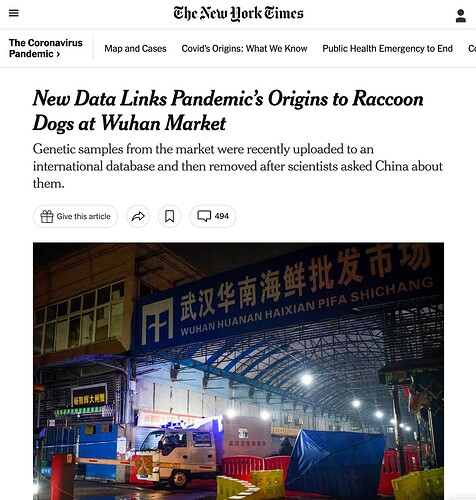-
国际病毒专家在中国武汉的一个市场上发现了基因数据,将冠状病毒与在那里出售的浣熊犬(貉)联系起来,提供了大流行可能是由受感染的动物引起的证据。从该市场提取的拭子,在阳性样本中发现了来自动物的遗传物质,包括浣熊犬(貉)。
-
这些杂乱无章的遗传物质并不能证明浣熊犬(貉)被感染了,目前还不清楚是动物把病毒传播给了人,还是病毒传播给了动物。然而,病毒和动物的遗传特征的存在与病毒从野生动物那里蔓延到人类的情况一致。
-
一份包含该研究结果全部细节的报告尚未发表,但该分析是由《大西洋》杂志首先报道的。
-
新的证据肯定会给有关该大流行病起源的辩论带来冲击,即使它并没有解决它是如何开始的问题。最近几周,所谓的实验室泄露理论,即认为冠状病毒是从武汉的一个研究实验室出现的,已经获得了支持。来自市场的基因数据提供了一些最具体的证据,说明病毒如何从实验室以外的野生动物身上扩散到人们身上。路易斯安那州立大学健康科学中心什里夫波特分校的病毒学家杰里米-卡米尔(Jeremy Kamil)说,研究结果表明,市场上有早期Covid品系的样本被野生动物的DNA读数污染。
-
卡米尔博士说,这些发现还不能成为感染动物引发大流行病的决定性证据。但是,他说,"它确实以一种亲密的方式使人们关注非法动物贸易。中国科学家在2022年2月发布了一项研究,研究了同样的市场样本,表明病毒来自在市场购物或工作的受感染者,而不是来自在那里出售的动物。在某个时候,这些研究人员将市场周围拭子的原始数据发布到GISAID,一个国际病毒基因序列库。
-
新的证据为大流行病的潜在起源提供了进一步的见解,尽管它并没有最终回答这个问题。它表明病毒可能来自实验室以外的野生动物,并且应该进一步调查非法动物贸易。它还表明,中国科学家对证据的描述并不完整,需要进一步研究,以便更全面地了解病毒是如何在华南市场传播的。
-
3月,进化生物学家Florence Débarre在一个与华南市场有关的数据库中发现了一个原始数据的宝库。自2022年2月以来,病毒专家一直在等待这一数据。一个国际团队,包括迈克尔-沃罗贝、克里斯蒂安-安德森和爱德华-霍姆斯,开始挖掘数据,并从与市场上一个摊位相连的手推车上发现了一个样本。
-
该样本含有病毒和一只浣熊犬(貉)的遗传物质。犹他大学的病毒学家Stephen Goldstein说,该团队能够迅速弄清该样本同时含有浣熊犬(貉)的核酸和病毒的核酸。国际团队联系了上传文件的中国研究人员,并提出进行合作。
-
在此之后,这些序列被从GISAID中删除,尽管目前还不清楚是谁删除了这些序列以及为什么。
-
Débarre博士和研究小组正在从从未公开的市场样本中寻求更多数据。病毒学家Angela Rasmussen评论说,鉴于人们在那里购物和工作,而且人类的Covid病例与该市场有关,人类的遗传物质是可以预期的。
-
戈德斯坦博士提醒说,研究小组没有被感染的动物,不能明确证明被感染的动物在摊位上。他说,该团队仍在分析数据,在发布报告之前,它不打算将其分析结果公之于众。
-
鉴于当时市场上存在的动物没有被采样,收集到的数据是该团队希望得到的最好结果。
-
International virus experts found genetic data in a market in Wuhan, China, linking the coronavirus to raccoon dogs for sale there, providing evidence that the pandemic could have been caused by an infected animal. Swabs were taken from the market and in positive samples, genetic material from animals, including raccoon dogs, was found.
-
The jumbled together genetic material does not prove that a raccoon dog was infected, and it is unclear whether the animal spread the virus to people or if the virus was spread to the animal. However, the presence of genetic signatures from the virus and the animal are consistent with the virus spilling into humans from a wild animal.
-
A report with the full details of the findings has not yet been published, but the analysis was first reported by The Atlantic.
-
The new evidence is sure to provide a jolt to the debate over the pandemic’s origins, even if it does not resolve the question of how it began. In recent weeks, the so-called lab leak theory, which posits that the coronavirus emerged from a research lab in Wuhan, has gained traction. Genetic data from the market offers some of the most tangible evidence yet of how the virus could have spilled into people from wild animals outside a lab. Jeremy Kamil, a virologist at Louisiana State University Health Sciences Center Shreveport, said the findings showed that the samples from the market that had early Covid lineages in them were contaminated with DNA reads of wild animals.
-
Dr. Kamil said that the findings fell short of conclusive evidence that an infected animal had set off the pandemic. But, he said, “it really puts the spotlight on the illegal animal trade in an intimate way.” Chinese scientists had released a study looking at the same market samples in February 2022, suggesting that the virus had come from infected people who were shopping or working in the market, rather than from animals being sold there. At some point, those same researchers posted the raw data from swabs around the market to GISAID, an international repository of genetic sequences of viruses.
-
The new evidence provides further insight into the potential origins of the pandemic, although it does not conclusively answer the question. It suggests that the virus could have come from wild animals outside a lab and that the illegal animal trade should be further investigated. It also suggests that Chinese scientists have given an incomplete account of the evidence and that further research is needed to gain a more complete understanding of how the virus was spreading at the Huanan market.
-
In March, evolutionary biologist Florence Débarre discovered a trove of raw data in a database related to the Huanan market. Virus experts had been waiting for this data since February 2022. An international team, including Michael Worobey, Kristian Andersen, and Edward Holmes, began to mine the data and found a sample from a cart linked to a stall at the market.
-
The sample contained genetic material from the virus and a raccoon dog. Stephen Goldstein, a virologist at the University of Utah, said that the team was able to figure out quickly that the sample contained both raccoon dog nucleic acid and virus nucleic acid. The international team contacted the Chinese researchers who uploaded the files and offered to collaborate.
-
After this, the sequences were removed from GISAID, although it is unclear who removed them and why.
-
Dr. Débarre and the research team are seeking more data from market samples that were never made public. Angela Rasmussen, a virologist, commented that human genetic material was to be expected given that people were shopping and working there and that human Covid cases had been linked to the market.
-
Dr. Goldstein cautioned that the team does not have an infected animal and cannot prove definitively that an infected animal was at the stall. He said that the team was still analyzing the data and that it had not intended for its analysis to become public before it had released a report.
-
Given that the animals present in the market were not sampled at the time, the data collected is as good as the team can hope to get.
